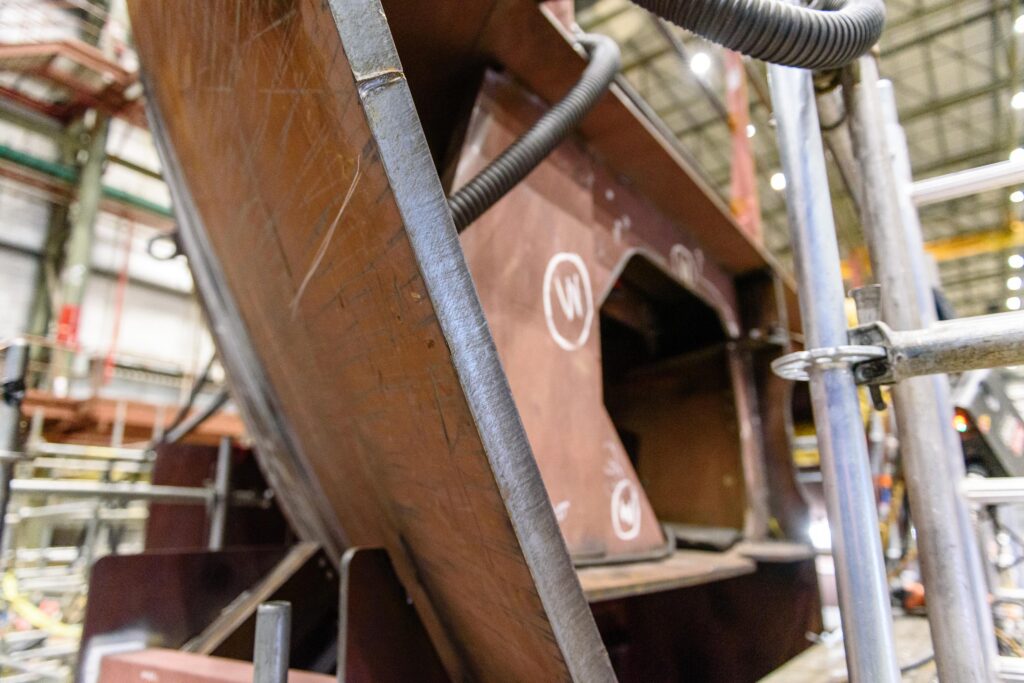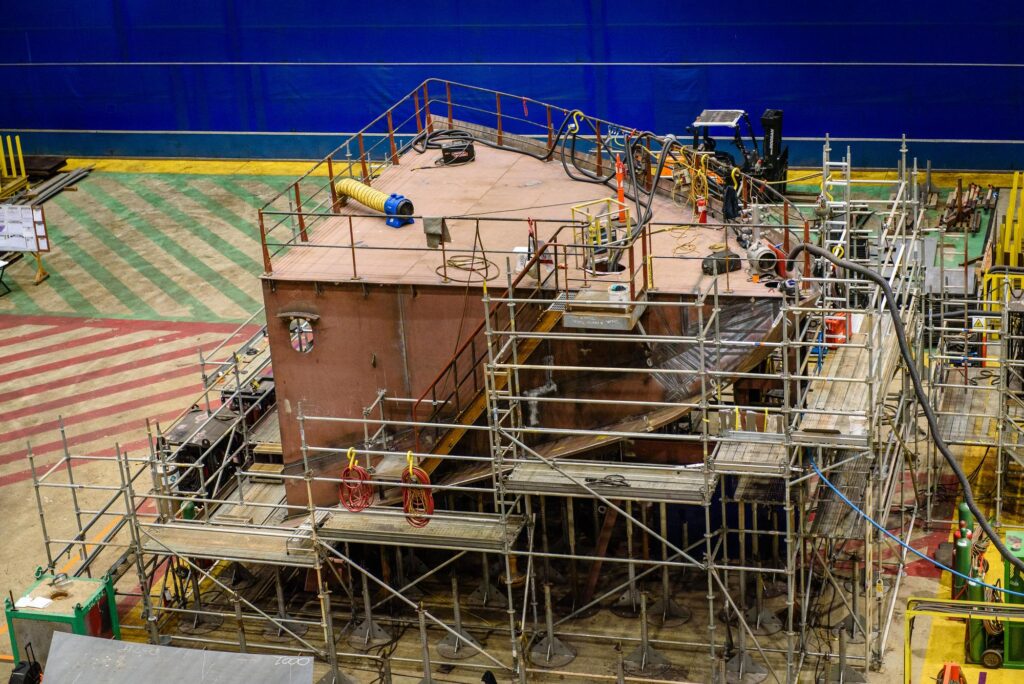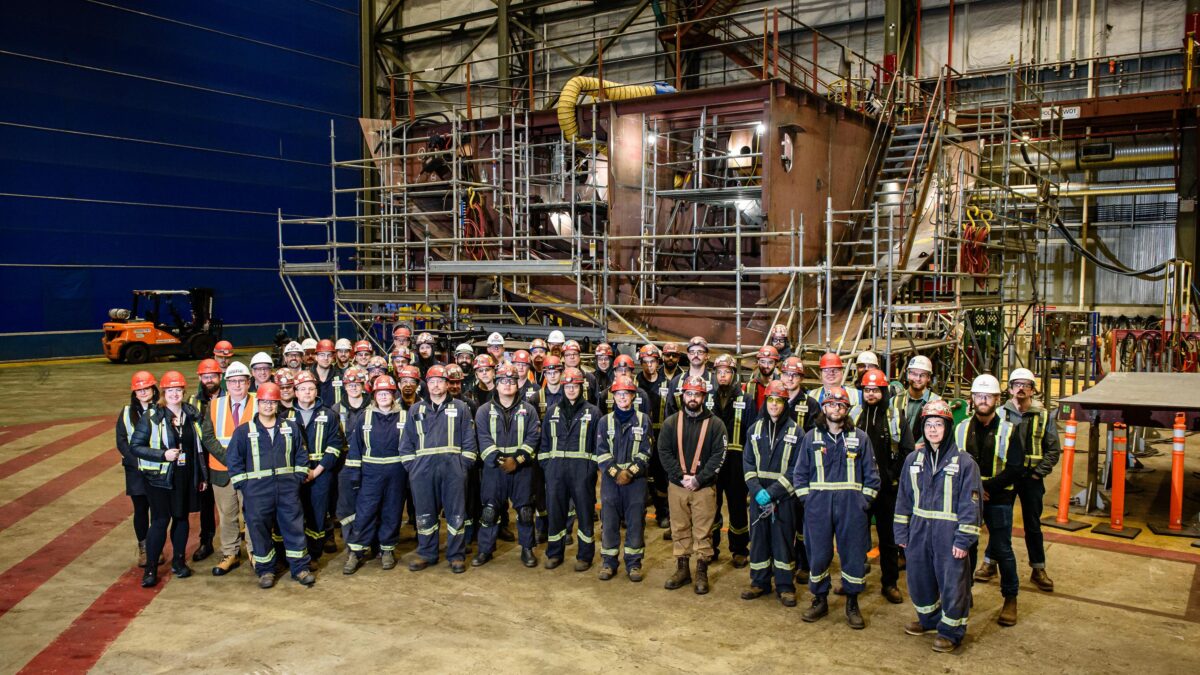Situated in North Vancouver British Columbia, Seaspan Shipyards (Seaspan) recently reached a major milestone with the completion of the ‘Prototype Block’ for the Canadian Coast Guard’s (CCG) Polar Icebreaker program. This achievement signals Seaspan’s readiness to embark on constructing Canada’s first heavy Polar Icebreaker in over six decades.
Crafting this Prototype Block was not merely a construction endeavor; it characterized Seaspan’s commitment to excellence and preparedness. Through meticulous planning and execution, Seaspan ensured that its production teams are equipped with the requisite processes, equipment, and expertise necessary to commence steel cutting on the Polar Icebreaker later this year. The journey of building the Prototype Block unveiled invaluable insights across three crucial domains: refining design for manufacturing, trialing new equipment and procedures, and validating top-tier manufacturing quality for the specialized and thicker steel utilized in the vessel’s construction.
“Having the opportunity for our engineering and production teams to work collaboratively to construct this Prototype Block very early in the design process was beneficial not only to Seaspan, but also to our customer and our cross-county supply chain. We are all working toward the same goal of delivering the Polar Icebreaker to the Canadian Coast Guard. Our skilled trades team has now seen, felt, tested, and worked on this specialized steel, so we are now better prepared to ensure that Seaspan begins full rate construction with a more mature design,” said Martin Edwards, Chief Program Officer at Seaspan Shipyards.
Unlike the steel employed in previous shipbuilding endeavors under the National Shipbuilding Strategy, the steel required for the Polar Icebreaker is doubly thick in certain sections, presenting a unique set of challenges. Maneuvering within tight frame spaces to bolster icebreaking capabilities further compounded the complexity. Welding this denser steel demanded additional time and finesse, underscoring the necessity of constructing the Prototype Block as a preparatory measure before diving into full-rate production.

Seaspan’s track record in designing and constructing Polar Class vessels underscores its expertise in this specialized domain. With notable projects such as the Offshore Fisheries Science Vessels and the ongoing construction of the Offshore Oceanographic Science Vessel, Seaspan has solidified its reputation as a pioneer in Polar Class vessel construction. The impending addition of the Polar Icebreaker to Seaspan’s portfolio will usher in a new era of maritime excellence, positioning Canada at the forefront of Arctic operations.
The Polar Icebreaker represents a technological marvel engineered to navigate the treacherous, ice-laden waters of the Arctic. Its deployment will be instrumental in facilitating the Canadian Coast Guard’s operations along more than 162,000 kilometers of Arctic coastline. From upholding Arctic sovereignty to spearheading high-Arctic research endeavors, the Polar Icebreaker will be a cornerstone in safeguarding Canada’s interests in the North.
“The completion of the Prototype Block for our Polar Icebreaker is an important milestone for the Canadian Coast Guard. We eagerly await its delivery as this vessel will extend Coast Guard on-water operations and ensure the continuous delivery of critical services in the high Arctic. This includes search and rescue, environmental and humanitarian response, supporting important ocean science and arctic sovereignty,” said Mario Pelletier, Commissioner of the Canadian Coast Guard.

As the venerable CCGS Louis S. St-Laurent nears its retirement after six decades of unwavering service, the Polar Icebreaker is poised to inherit the mantle of Canada’s flagship icebreaker. With a displacement of 27,876 tonnes, spanning 158 meters in length and 28 meters in width, the Polar Icebreaker will surpass its predecessors in both size and capability. Outfitted with state-of-the-art amenities and a crew capacity of up to 100 personnel, it will redefine the boundaries of Arctic exploration.
Central to the Polar Icebreaker’s mission are endeavors to safeguard Canada’s sovereignty, advance Arctic research, facilitate environmental response initiatives, ensure Northern resupply operations, and bolster search and rescue capabilities. Noteworthy design features, including its IACS Polar Class 2 (PC2) Heavy Icebreaker classification, over 40MW of installed power, and a versatile multi-role mission capability, highlight its adaptability to diverse operational requirements.
Moreover, the Polar Icebreaker’s advanced infrastructure, including scientific laboratories, a moon pool for equipment deployment, a helicopter flight deck and hangar, and provisions for future Remotely Piloted Aircraft System (RPAS) capability, accentuate its versatility in meeting evolving maritime challenges.
Underpinning Seaspan’s remarkable journey is its role as a pivotal economic and employment generator. According to Deloitte’s economic analysis, Seaspan’s contributions have amounted to a staggering $5.7 billion to Canada’s GDP since 2012, while fostering the creation and sustenance of over 7,000 jobs annually.
In essence, Seaspan’s triumph in constructing the Prototype Block symbolizes more than mere shipbuilding prowess; it embodies a commitment to innovation, excellence, and national progress. As Canada braces itself for a new era of Arctic exploration and stewardship, Seaspan stands as a beacon of maritime ingenuity, poised to navigate the uncharted waters of tomorrow.

